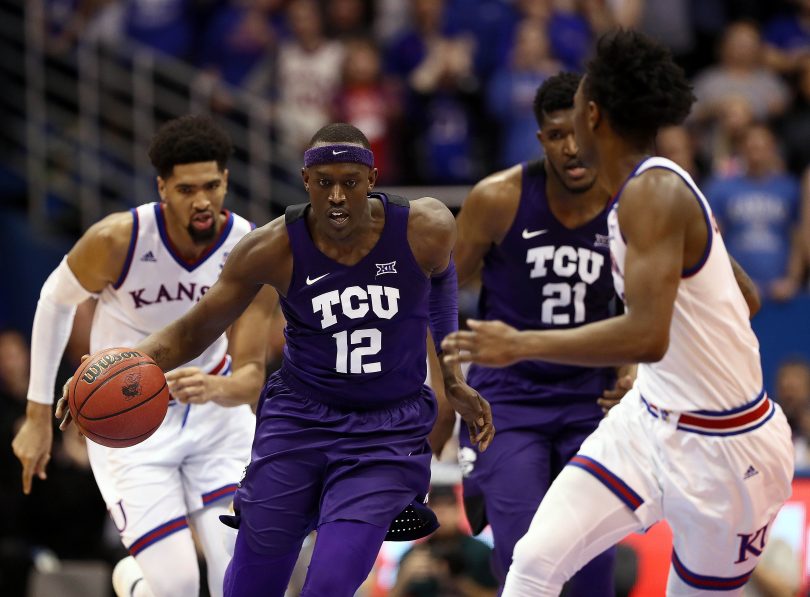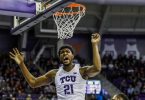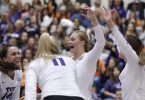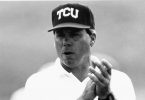Soon after Texas finished off an NIT championship in New York, Longhorns coach Shaka Smart ruminated briefly over the saga of Kerwin Roach, a player he had to suspend for the last five games of the regular season before returning to atone with his play in the postseason.
“I don’t think he thought he would be in college this long,” said Smart, as part of his answer. “None of them really do.”
None of them really do.
In other words, most believe they will go pro long before exhausting four or five years of college eligibility.
Only days later, TCU forward Kouat Noi and Desmond Bane announced that they were entering their names in the NBA Draft. Former Horned Frogs guard Jaylen Fisher announced the same.
Noi said he was “all in” in going pro. Bane and Fisher couched their declarations, saying they were keeping their options open, meaning they might ultimately decide to return to school. (Fisher has said if he returns to college it will be at another school.)
The NBA provides underclassmen who declare early for the draft an evaluation of their prospects so that they’ll have a fuller understanding of their status as a prospect before making a final decision.
The evaluations on those three will likely include “not expected to be drafted.”
Players can withdraw their names from the draft and return to school by notifying the NBA no later than 5 p.m., May 29.
The data in this data-driven society is against not only those three, but most – actually almost all — of their peers as far as a career in the NBA goes.
In two rounds of the draft, there are 60 draft slots for more than 4,000 draft-eligible players. Of those a year ago, 52 went to NCAA players. Seven others were international players, and another came from a prep school. On average, 11 international players have been drafted each year since 2008.
The number works out to 4.2 percent of 1,230 draft-eligible Division I players selected. That number improves to 53 percent of D-I players when calculating the total of those who compete in the NBA, G-League or internationally in their first year after leaving college.
So, those are obviously better odds, though far from a sure thing.
In the 2018 draft, there were 236 early entries, including 181 from colleges and post-graduate institutions and 55 internationals.
All vying for 60 slots.
Smart’s words exemplified: None of them really do.
If you don’t have a dream, how can you make one come true? No one here wishes to put a kibosh on a dream. We have them, too.
But history is full of valuable lessons, perhaps none more important than the example of Sam Norton.
In the 1984 draft, nine players with college eligibility remaining declared for the draft. In those days, players generally didn’t leave until after their junior seasons. It was almost the rule, though there were a few who came out before. Magic Johnson and Isaiah Thomas were two notable players who came out as sophomores. Those early entrants in 1984 were Hakeem Olajuwon, Michael Jordan, Charles Barkley, Tim McCormick and Eric Turner of Michigan, Stuart Gray of UCLA, Cory Blackwell of Wisconsin, Yommy Sangodeyi of Sam Houston State.
The ninth was Sam Norton, who announced that he planned to skip his senior season at UT Arlington.
Norton, who played for Jim Wall at Fort Worth Paschal High School, was an exemplar of F. Scott Fitzgerald’s “show me a hero and I’ll write you a tragedy.”
Norton played on what Wall called probably his most talented team in four decades of coaching. His teammates included Charles Harris and 6-9 Sam Donnell, who both went on to play at UTA. The Panthers in the 1980-81 season played three memorable games against Robert Hughes’ Dunbar teams, which featured Willie Ashley and Robert Hughes Jr. Dunbar won all three games, including the last for the district title in front of a sold-out Daniel-Meyer Coliseum at TCU.
Norton averaged 28 points a game his senior season, but he was under-recruited because of his size. He was a 6-foot-6 center, who was limited otherwise. Most notably, he didn’t have much range on a jumper and he couldn’t put the ball on the floor.
A newspaper report at the time suggested DePaul also had shown interest in Norton, though it appeared the reporter’s source was the player. Wall recalled that it was only lower Division I schools, such as Northwestern State and Stephen F. Austin, in addition to UTA, that recruited Norton.
“He was a heckuva player,” Wall recalled. “If he had been 6-8, he could’ve played in the NBA. He was one of those kids who had some intangible things I couldn’t coach. He just had a knack for the basketball. It’s kind of like he videotaped 4,000 shots and see if that ball hits here it’s going to go right there. He was always where the ball was. It was uncanny.”
The world is full of very good players who never sniff the NBA.
Norton had a very good junior year on the stage at Texas Hall on Cooper Street, averaging 21 points and 11 rebounds a game. In two games against Karl Malone, then a sophomore, and Louisiana Tech, Norton scored a combined 42 points and pulled down 22 rebounds.
“He was a good player who fit our situation, but he was a 6-6 postman who couldn’t handle the ball or shoot from the outside,” said Bob “Snake” LeGrand, his coach at UTA. “He wasn’t going to make it in the NBA, and I tried to talk him out of it. He was a great player for us. In the NBA, it’s a whole lot different.”
LeGrand was adamant, and he was public about it at the time, telling reporters then that Norton’s decision was a “stupid thing.”
“I think he’s going to get messed up in this deal,” LeGrand said in 1984. “In fact, I’m sure he is.”
That year, 228 players were selected in 10 rounds.
Norton was not one of them, the only one of the nine underclassmen not selected. He left UTA with no degree, no basketball and fewer prospects.
Thirty-five years later, LeGrand was as insistent.
“First of all, some of it ain’t printable,” LeGrand said when asked what he told Norton at the time. “‘Sam, be realistic. I’m going to be honest with you as your coach and your friend, it ain’t gonna happen.’
“I pointed out those same things [his deficiencies]. I told him those things. It didn’t make any difference. His dad had him convinced he could make the NBA. That was it. There was no convincing them.”
LeGrand described Norton’s dad as an early version of LaVar Ball.
“That’s what this was.”
Norton still lives in Fort Worth. Attempts to reach him are ongoing.
Those with knowledge of his situation said he is in declining health at age 56.
“I tried to talk to him on several occasions,” LeGrand said. “There probably was an agent who talked to his dad … I’m not sure about that. I’m not sure his dad wasn’t going to act as his agent.”







